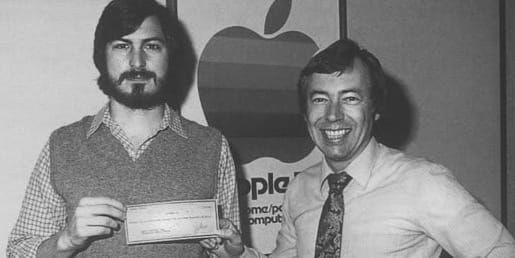- Investor Briefcase
- Posts
- The investor that built Silicon Valley
The investor that built Silicon Valley
Inside Don Valentine’s early bets on companies that changed the world
Don Valentine built Sequoia Capital by backing engineers with ideas the market didn’t yet understand. He believed that product-focused founders would create the future of technology, not salesmen or financiers. Starting in the 1970s, he invested early in companies like Atari, Apple, and Cisco. He turned Sequoia into a firm known for timing markets and backing conviction.

This week, we explore how Don Valentine pioneered venture capital in Silicon Valley and why he backed founders that others overlooked:
🏛️ Sequoia and backing technical founders
💵 Backing startups no one believed in
🤝 Passing on the mantle
— Investor Briefcase Team



Don Valentine started his career selling semiconductors at Fairchild and National Semiconductor, two of the companies that helped shape early Silicon Valley. Working closely with engineers, he saw how many had the skills to build great products but couldn’t get the support they needed to grow into real businesses. Venture capital was still a new idea at the time, but Valentine saw the gap clearly.
In 1972, he launched Sequoia Capital with a goal of backing technical founders early and only when the timing made sense. He wasn’t interested in hype or abstract trends. He believed good products, built by the right teams, would find their markets if they solved a real problem.
“We were not interested in backing people who were interested in money. We were interested in backing people who were interested in solving problems.”
One of his first major investments was in Atari. The company was messy, poorly run, and still figuring things out, but Valentine saw potential. He invested $150,000, giving it the breathing room to grow. That same approach led him to back companies like Tandem Computers and LSI Logic. His pattern was consistent: he looked for sharp engineers building things people actually needed.
From the start, Valentine made it clear that Sequoia wasn’t chasing buzz. He was building a firm around builders.



Steve Jobs & Steve Wozniak
In 1977, Valentine heard about two guys working on personal computers in a garage. The tip came from a contact at Atari, where one of them, Steve Jobs, had been an employee. Valentine didn’t invest directly but he didn’t ignore it either. He introduced Jobs and Wozniak to Mike Markkula, a former Intel executive, who gave them early capital and helped formalize Apple’s business structure.
That moment captured how Valentine worked. Even when he didn’t lead a deal, he stayed close to the people building something important. Later, he put Sequoia behind Cisco, a company most investors ignored. Networking hardware wasn’t glamorous, but Valentine saw where the internet was going. He met founders Len Bosack and Sandy Lerner, saw that their product worked, and gave them the capital to take it further.
“The art of storytelling is incredibly important... that's how the money works. The money flows as a function of the story.”
Valentine didn’t get swept up in pitch decks or grand visions. He asked simple questions. What’s the product? Who wants it? Will they pay for it? If the answers were clear, he moved quickly. He rarely cared about credentials or past roles. What mattered was whether the founder could build something useful and get it into people’s hands.
By the end of the 1980s, Sequoia had earned a reputation as the firm that could spot a winner before it looked like one.

Sponsored by Pacaso
The key to a $1.3T opportunity
A new real estate trend called co-ownership is revolutionizing a $1.3T market. Leading it? Pacaso. Led by former Zillow execs, they already have $110M+ in gross profits with 41% growth last year. They even reserved the Nasdaq ticker PCSO. But the real opportunity’s now. Until 5/29, you can invest for just $2.80/share.
This is a paid advertisement for Pacaso’s Regulation A offering. Please read the offering circular at invest.pacaso.com. Reserving a ticker symbol is not a guarantee that the company will go public. Listing on the NASDAQ is subject to approvals. Under Regulation A+, a company has the ability to change its share price by up to 20%, without requalifying the offering with the SEC.



By the time Don Valentine stepped away from active investing in the 1990s, Sequoia already had its blueprint. The firm stayed lean, backed a few high-conviction ideas, and built deep relationships with founders. Valentine taught his team to ask hard questions early, avoid chasing trends, and focus on finding people who cared more about solving a problem than building a résumé.
Those principles carried through the next generation. Sequoia expanded globally but kept its focus tight. The same playbook that worked for Atari and Cisco worked again for companies like Google, YouTube, WhatsApp, Airbnb, and Stripe. The details changed, but the core focus remained: spot technical founders early, support them with trust and discipline, and stay close without getting in the way.
“Our job is to help the entrepreneur achieve their dream. It's not our dream. It's their dream.”
Valentine changed how venture capital firms thought about structure. He preferred small teams, long-term partnerships, and firms that stuck around to help. Today, many VC firms try to mirror the Sequoia model, but few have maintained its consistency across decades.
Valentine passed away in 2019, but his fingerprints are still all over Sequoia’s culture. He didn’t talk much about vision or disruption. He just wanted to find the best builders and give them what they needed. And as it turns out, that’s still the winning strategy.

More Stories
Other major venture capital pioneers
> Peter Thiel: A co-founder of PayPal and Palantir, Thiel was the first outside investor in Facebook, turning a $500,000 investment into over $1 billion. As a founder of Founders Fund and Valar Ventures, Thiel has backed numerous disruptive startups, leveraging his experience as an entrepreneur and investor to shape the next generation of tech leaders.
> John Doerr: After a successful stint at Intel, Doerr joined Kleiner Perkins in 1980 and became one of the most influential VCs in history. He backed transformative companies like Amazon, Google, Compaq, Intuit, and Sun Microsystems, helping to create over 150,000 jobs. Doerr is known for his hands-on approach, deep involvement in company strategy, and advocacy for innovation in both technology and education.
> Mary Meeker: Dubbed the “Queen of the Internet,” Meeker made her mark as a Wall Street analyst before joining Kleiner Perkins and later founding her own firm, Bond Capital. She was an early champion of companies like Facebook, Twitter, Spotify, Slack, and Airbnb, with a focus on internet and technology trends. Her investments in Canva and Plaid reached multi-billion dollar valuations, and she is recognized for her influential annual Internet Trends reports.

Each week we profile the most notorious investment stories.
Got an idea for a story? Email us at [email protected]
